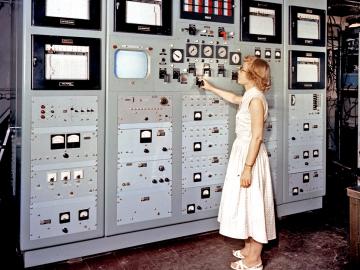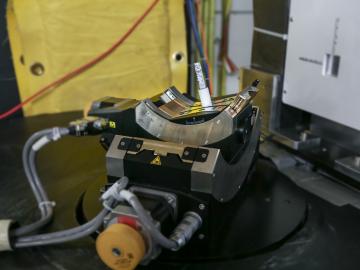
Filter News
Area of Research
- Advanced Manufacturing (3)
- Biology and Environment (20)
- Biology and Soft Matter (1)
- Computational Biology (1)
- Computational Engineering (1)
- Computer Science (5)
- Electricity and Smart Grid (1)
- Energy Science (26)
- Functional Materials for Energy (1)
- Fusion and Fission (8)
- Fusion Energy (1)
- Isotopes (4)
- Materials (47)
- Materials for Computing (4)
- National Security (7)
- Neutron Science (13)
- Nuclear Science and Technology (4)
- Quantum information Science (1)
- Supercomputing (49)
News Type
News Topics
- (-) Artificial Intelligence (100)
- (-) Chemical Sciences (59)
- (-) Composites (25)
- (-) Frontier (48)
- (-) Physics (44)
- (-) Space Exploration (24)
- 3-D Printing/Advanced Manufacturing (106)
- Advanced Reactors (30)
- Big Data (66)
- Bioenergy (90)
- Biology (106)
- Biomedical (57)
- Biotechnology (28)
- Buildings (57)
- Clean Water (30)
- Computer Science (169)
- Coronavirus (34)
- Critical Materials (18)
- Cybersecurity (23)
- Education (2)
- Emergency (4)
- Energy Storage (79)
- Environment (178)
- Exascale Computing (54)
- Fossil Energy (7)
- Fusion (56)
- Grid (57)
- High-Performance Computing (104)
- Hydropower (12)
- Irradiation (3)
- Isotopes (46)
- ITER (8)
- Machine Learning (53)
- Materials (118)
- Materials Science (109)
- Mathematics (11)
- Mercury (10)
- Microelectronics (3)
- Microscopy (42)
- Molten Salt (8)
- Nanotechnology (41)
- National Security (70)
- Neutron Science (122)
- Nuclear Energy (98)
- Partnerships (43)
- Polymers (23)
- Quantum Computing (41)
- Quantum Science (63)
- Security (20)
- Simulation (55)
- Software (1)
- Statistics (3)
- Summit (50)
- Transportation (77)
Media Contacts

Oak Ridge National Laboratory scientists designed a recyclable polymer for carbon-fiber composites to enable circular manufacturing of parts that boost energy efficiency in automotive, wind power and aerospace applications.

Nine student physicists and engineers from the #1-ranked Nuclear Engineering and Radiological Sciences Program at the University of Michigan, or UM, attended a scintillation detector workshop at Oak Ridge National Laboratory Oct. 10-13.

Sheng Dai, a Corporate Fellow and section head at the Department of Energy’s Oak Ridge National Laboratory, has been selected by the DOE Office of Science as a 2023 Distinguished Scientist Fellow.

The Earth System Grid Federation, a multi-agency initiative that gathers and distributes data for top-tier projections of the Earth’s climate, is preparing a series of upgrades.

ORNL researchers are deploying their broad expertise in climate data and modeling to create science-based mitigation strategies for cities stressed by climate change as part of two U.S. Department of Energy Urban Integrated Field Laboratory projects.

Oak Ridge National Laboratory physicist Elizabeth “Libby” Johnson (1921-1996), one of the world’s first nuclear reactor operators, standardized the field of criticality safety with peers from ORNL and Los Alamos National Laboratory.

Researchers at the Department of Energy’s Oak Ridge National Laboratory and their technologies have received seven 2022 R&D 100 Awards, plus special recognition for a battery-related green technology product.

ORNL Corporate Fellow and Center for Nanophase Materials Sciences researcher Bobby Sumpter has been named fellow of two scientific professional societies: the Institute of Physics and the International Association of Advanced Materials.

Oak Ridge National Laboratory researchers are developing a first-of-its-kind artificial intelligence device for neutron scattering called Hyperspectral Computed Tomography, or HyperCT.

Researchers at ORNL are tackling a global water challenge with a unique material designed to target not one, but two toxic, heavy metal pollutants for simultaneous removal.


